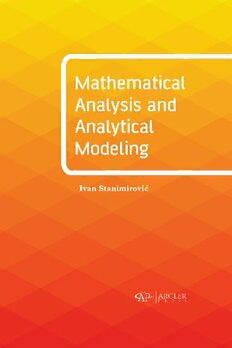Table Of ContentMATHEMATICAL ANALYSIS AND
ANALYTICAL MODELING
MATHEMATICAL ANALYSIS AND
ANALYTICAL MODELING
Ivan Stanimirović
ARCLER
P r e ss
www.arclerpress.com
Mathematical Analysis and Analytical Modeling
Ivan Stanimirović
Arcler Press
2010 Winston Park Drive,
2nd Floor
Oakville, ON L6H 5R7
Canada
www.arclerpress.com
Tel: 001-289-291-7705
001-905-616-2116
Fax: 001-289-291-7601
Email: [email protected]
e-book Edition 2020
ISBN: 978-1-77407-407-7 (e-book)
This book contains information obtained from highly regarded resources. Reprinted material
sources are indicated and copyright remains with the original owners. Copyright for images and
other graphics remains with the original owners as indicated. A Wide variety of references are
listed. Reasonable efforts have been made to publish reliable data. Authors or Editors or Publish-
ers are not responsible for the accuracy of the information in the published chapters or conse-
quences of their use. The publisher assumes no responsibility for any damage or grievance to the
persons or property arising out of the use of any materials, instructions, methods or thoughts in
the book. The authors or editors and the publisher have attempted to trace the copyright holders
of all material reproduced in this publication and apologize to copyright holders if permission has
not been obtained. If any copyright holder has not been acknowledged, please write to us so we
may rectify.
Notice: Registered trademark of products or corporate names are used only for explanation and
identification without intent of infringement.
© 2020 Arcler Press
ISBN: 978-1-77407-321-6 (Hardcover)
Arcler Press publishes wide variety of books and eBooks. For more information about
Arcler Press and its products, visit our website at www.arclerpress.com
ABOUT THE AUTHOR
Ivan Stanimirovic gained his PhD from University of Niš, Serbia in 2013.
His work spans from multi-objective optimization methods to applications of
generalized matrix inverses in areas such as image processing and computer
graphics and visualisations. He is currently working as an Assistant professor
at Faculty of Sciences and Mathematics at University of Niš on computing
generalized matrix inverses and its applications.
TABLE OF CONTENTS
List of Figures ........................................................................................................ix
List of Tables .........................................................................................................xi
Preface........................................................................ .......................................xiii
Chapter 1 Preliminaries .............................................................................................1
1.1. Metric Spaces .....................................................................................1
1.2. Complex Variable ...............................................................................5
1.3. Complex Functions .............................................................................9
1.4. Singularities Classes And Classes Of Functions .................................13
1.5. Curves, Contours, And Simple-Minded Domains Related ..................14
Chapter 2 Normal Families ......................................................................................17
2.1. Sequence Of Functions .....................................................................17
2.2. Compactness And Convergence In The Space Of
Analytical Functions .......................................................................18
2.3. Arsela-Ascoli Theorem And Montel ...................................................20
Chapter 3 Iteration Functions, Fixed Points And
Fatou And Julia Sets ................................................................................27
3.1. Iteration Of Functions And Points......................................................27
3.2. Fatou And Julia Set ............................................................................31
3.3. Fatou Assembly Components ............................................................32
3.4. Classification Of Periodic Components For Functions .......................33
Chapter 4 Baker Theorem For Completely Invariant Components In
The Set Of Fatou .....................................................................................37
4.1. Definitions And Results .....................................................................37
4.2. Demonstration Of Baker’s Theorem ...................................................38
Chapter 5 Mathematical Analysis Of Significant Transformations Of
The Transverse Projects ...........................................................................41
Chapter 6 Theoretical Framework ...........................................................................55
6.1. Theoretical Background ....................................................................55
6.2. Conceptual Framework .....................................................................64
6.3. Regulatory Framework ......................................................................76
6.4. Developed Method ...........................................................................80
6.5. Recommendations And Limitations .................................................110
Chapter 7 Applying Analytical Functions In
Educational Research ............................................................................113
7.1. Approach And Problem Formulation ...............................................114
7.2. Background To The Problem Under Study .......................................118
7.3. Vie Model Overview .......................................................................126
7.4. Variability Model Of Educational Research Or Model Vie ...............128
7.5. The Extra-Framework Component ...................................................129
7.6. Encompassing Theoretical Empirical Result .....................................136
7.7. Patterns Methodology .....................................................................138
7.8. Contrasting Operations And Validation ...........................................139
7.9. Balancing The Components Which Are Logical-Structural ...............141
7.10. Base Epistemological Predominant ...............................................142
Chapter 8 Methodological Framework ..................................................................143
8.1. Level Or Stage Of Research ............................................................143
8.2. Design Chosen For Data Collection ................................................143
8.3. Study Units .....................................................................................143
8.4. Techniques And Instruments For Data Collection ............................144
8.5. Technical Data Analysis ..................................................................144
8.6. Technical Reliability Of Life And
Employee Instrument ....................................................................144
8.7. Process ...........................................................................................144
Chapter 9 Conclusions And Recommendations .....................................................147
9.1. Recommendations For The Study ....................................................148
Bibliography ..........................................................................................151
Index .....................................................................................................157
viii

